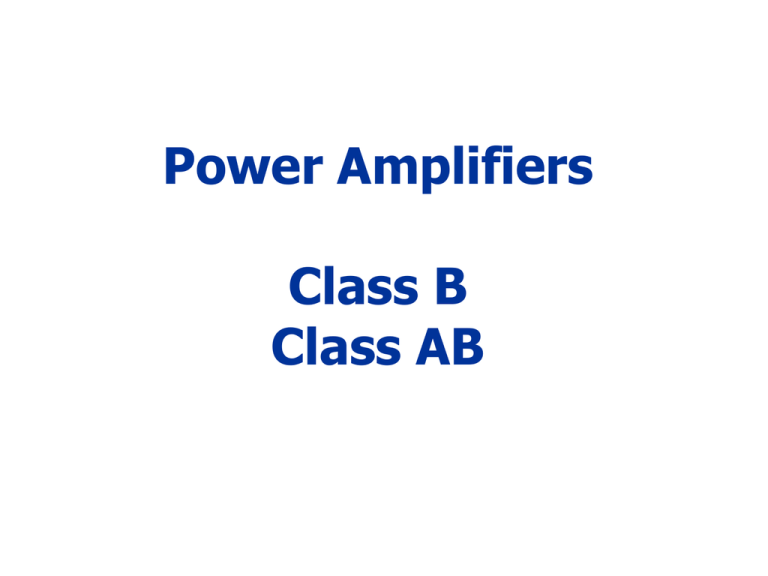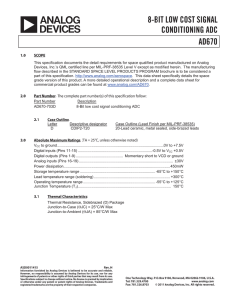Power Amplifiers Class B Class AB
advertisement

Power Amplifiers Class B Class AB Class B The circuit each transistor conducts for a half of every signal period complementary pair push-pull arrangement Operation vI (0.6V; 0.6V) T1 – (off), T2 – (off) vI 0.6V T1 – (on), T2 – (off) vO vI vBE1 vI 0.6V iO 0 iC1 iO iC 2 0 vo max VCC VCEsat VCC vO 0V vI 0.6V T1 –(off), T2 –(on) vO vI vBE 2 vI 0.6V iO 0 iC 2 iO iC1 0 vo min VCC VCE1sat VCC Voltage transfer characteristic crossover distortions Waveforms Assume the signal magnitude sufficiently high to neglect the crossover distortions. vo (t ) Vˆo sin t Vˆo VCC Powers. Efficiency T 2 T Vˆo sin t 1 1 PPS VCC iPS (t )dt VCC dt T0 T 0 RL T 2 ˆ ˆ V V 1 V V 1 2 CC o CC o PPS PPS sin t dt RL T RL 0 T PO PPS PPS PPS PPS PO VOrms I Orms 2 VCCVˆo RL VˆO2 2 RL Average efficiency: For Vˆo VCC For VˆO VCC PPS max PO max 2 2 VCC RL 2 VCC 2 RL PO VˆO2 RL VˆO ˆ PPS 2 RL 2 VCCVO 4 VCC Maximum average efficiency: for VˆO VCC max 4 78.5% The amplifying transistor PT OPTIONAL 1 1 VCCVˆo Vˆo2 PT PPS PO 2 RL 4 RL 2 ˆ2 ˆ2 V V V 1 CC VˆO VCC PT CC 0.068 CC RL 4 RL RL 1 PPS PO 2 Maximum efficiency: What is the maximum average power dissipated by a transistor depending on the output voltage magnitude? dPT 0 ˆ dV V̂o O Maximum average power: Maximum instantaneous power: iC max 2 VCC 0.64VCC V̂o 0.64VCC Vˆo VCC VCC RL PT max 2 2 VCC 1 VCC 2 0.1 RL RL pT max 2 2 VCC 1 VCC 0.25 4 RL RL vCE max 2VCC Class AB - Crossover distortion, specific to class B amplifier can be virtually eliminated Class AB Amplifier. Basic Circuit • biasing the complementary output transistors at a small output current VBias≈ 0.6V I ISe vI - positive vO t vI t VBias VBEn vI t vI - negative vO t vI t VBias VBEp vI t VBias VT Voltage Transfer Characteristic (VTC) Solutions to generate VBias ??? Biasing using Diodes R should allow the currents in the diodes and in the bases of the transistors, even for maximum output current Vˆ 8V β=50 V = +15V CC O RL=100Ω, ID1=1.5mA R=?, IR=? (each R) T is the driver transistor from previous amplifier stage Biasing using VBE Multiplier VBB R1 VBE1 1 R2 Short-Circuit Protection Protection against the effect of short-circuiting the output • Effective in ensuring device safety • Disadvantage: under normal operation up to 0.6V appears across each protection resistor. The voltage swing will be reduced by that much, in each direction • Negative feedback, protection of the output transistor against thermal runaway iOmax VBE 2 0,6V REn REn Illustration I Bias 0.6 0.6 0.6 6mA 0.1 P - adjusts the biasing voltage between VBE and 3.5VBE C - in the bases of Tn and Tp it is the same variable input voltage iOmax=0.6A Use of Compound Transistors with Higher Current Gain • Necessary for high output currents The Darlington npn configuration The compound pnp configuration preferred in IC Exercise ± VCC = ± 15V RL1 500Ω RL 2 50Ω a) What is the expression vO(vi) for vi[-10V;10V]? Plot the vO(vi) VTC. What is the operating class of this aplifier? What is the maximum theoretical average efficiency? b) Plot vO(t) for: (1) vi(t)= 0.2sint [V]; (2) vi(t)= 10sint [V]. c) For vi(t)= 10sint [V], vO(t) can be well approximated by a sinewave (negleting crossover distorsions). Compute: the average output power, the average power consumption, and the average efficiency of the stage. Plot the collector-emiter voltage and colector current for T1 and T2. d) Propose a solution to eliminate crossover distorsion


